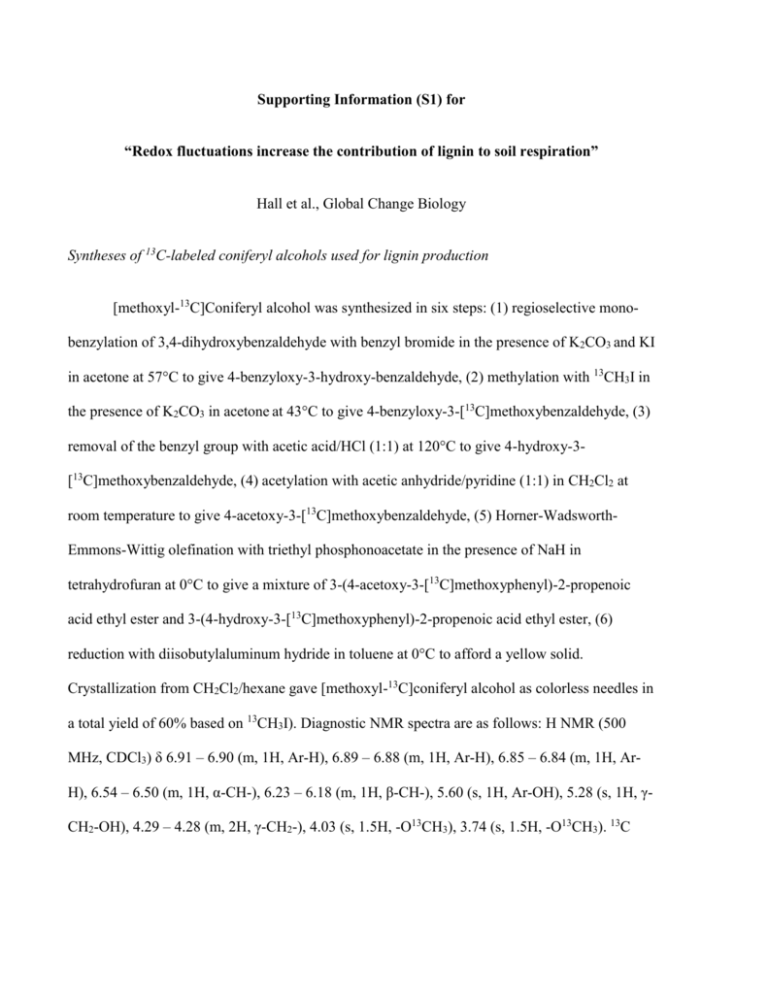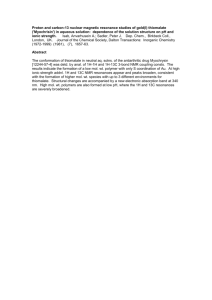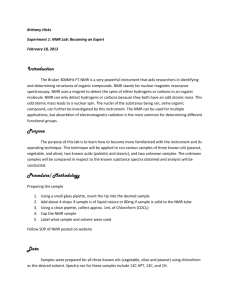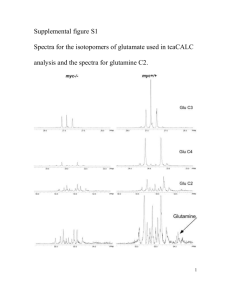gcb12908-sup-0001
advertisement

Supporting Information (S1) for “Redox fluctuations increase the contribution of lignin to soil respiration” Hall et al., Global Change Biology Syntheses of 13C-labeled coniferyl alcohols used for lignin production [methoxyl-13C]Coniferyl alcohol was synthesized in six steps: (1) regioselective monobenzylation of 3,4-dihydroxybenzaldehyde with benzyl bromide in the presence of K2CO3 and KI in acetone at 57°C to give 4-benzyloxy-3-hydroxy-benzaldehyde, (2) methylation with 13CH3I in the presence of K2CO3 in acetone at 43°C to give 4-benzyloxy-3-[13C]methoxybenzaldehyde, (3) removal of the benzyl group with acetic acid/HCl (1:1) at 120°C to give 4-hydroxy-3[13C]methoxybenzaldehyde, (4) acetylation with acetic anhydride/pyridine (1:1) in CH2Cl2 at room temperature to give 4-acetoxy-3-[13C]methoxybenzaldehyde, (5) Horner-WadsworthEmmons-Wittig olefination with triethyl phosphonoacetate in the presence of NaH in tetrahydrofuran at 0°C to give a mixture of 3-(4-acetoxy-3-[13C]methoxyphenyl)-2-propenoic acid ethyl ester and 3-(4-hydroxy-3-[13C]methoxyphenyl)-2-propenoic acid ethyl ester, (6) reduction with diisobutylaluminum hydride in toluene at 0°C to afford a yellow solid. Crystallization from CH2Cl2/hexane gave [methoxyl-13C]coniferyl alcohol as colorless needles in a total yield of 60% based on 13CH3I). Diagnostic NMR spectra are as follows: H NMR (500 MHz, CDCl3) δ 6.91 – 6.90 (m, 1H, Ar-H), 6.89 – 6.88 (m, 1H, Ar-H), 6.85 – 6.84 (m, 1H, ArH), 6.54 – 6.50 (m, 1H, α-CH-), 6.23 – 6.18 (m, 1H, β-CH-), 5.60 (s, 1H, Ar-OH), 5.28 (s, 1H, γCH2-OH), 4.29 – 4.28 (m, 2H, γ-CH2-), 4.03 (s, 1.5H, -O13CH3), 3.74 (s, 1.5H, -O13CH3). 13C NMR (126 MHz, CDCl3) δ 146.82, 146.81, 145.73, 145.70, 131.51, 129.38, 126.27, 120.43, 114.66, 108.52, 108.48, 63.98, 56.02. [2-13C]Coniferyl alcohol was synthesized in two steps: (1) Horner-Wadsworth-EmmonsWittig olefination of 4-acetoxy-3-methoxybenzaldehyde with [2-13C]triethyl phosphonoacetate in the presence of NaH in tetrahydrofuran at 0°C, followed by a gradual temperature increase to 60°C, to give 3-(4-acetoxy-3-methoxyphenyl)-2-[13C]propenoic acid ethyl ester, (2) reduction with diisobutylaluminum hydride in toluene at 0°C to afford a yellow solid. Crystallization from CH2Cl2/hexane gave [2-13C]coniferyl alcohol as colorless needles in a total yield of 83% based on [2-13C]triethyl phosphonoacetate. Diagnostic NMR spectra are as follows: H NMR (500 MHz, acetone-d6) δ 7.61 (bs, 1H, Ar-OH), 7.05 – 7.04 (m, 1H, Ar-H), 6.86 – 6.84 (m, 1H, Ar-H), 6.76 – 6.75 (m, 1H, Ar-H), 6.50 – 6.47 (m, 1H, α-CH-), 6.39 – 6.34 (m, 0.5H, β-13CH-), 6.09 – 6.04 (m, 0.5H, β-13CH-), 4.20 – 4.17 (m, 2H, γ-CH2-), 3.85 (s, 3H, -OCH3), 3.76 (bs, 1H, γ-CH2OH). 13C NMR (126 MHz, acetone-d6) δ 148.40, 147.12, 130.63, 130.23, 130.05, 128.10, 121.49, 120.60, 120.56, 115.72, 109.92, 109.89, 63.56, 63.17, 56.11. Lignin preparations Synthetic guaiacyl lignins were produced by polymerizing the resultant coniferyl alcohols in vitro with horseradish peroxidase (Sigma/Aldrich, type VI) (Kirk & Brunow, 1988). The prepared synthetic lignins were fractionated by gel permeation chromatography on a 1.8 × 33 cm column of Sephadex LH-20 in N,N-dimethylformamide to obtain a high molecular weight fraction. The material eluting in the void volume of the column (i.e., excluded from the pores of the Sephadex matrix, mol. wt. > 1000) (Kirk & Brunow, 1988), was used for the experiments reported here. The collected lignin solutions were concentrated by rotary vacuum evaporation of most of the N,N-dimethylformamide, and the lignins were then precipitated by adding the concentrated solutions dropwise to 20 volumes of rapidly stirring distilled, deionized water. The precipitates were collected by centrifugation (3000 × g), resuspended in distilled, deionized water and centrifuged again likewise, resuspended once more in distilled, deionized water, and finally lyophilized to yield in each case a beige powder. 13C NMR analysis of the lignins showed chemical shifts and substructure frequencies consistent with those reported earlier for synthetic guaiacyl lignin (Landucci et al., 1998). References Kirk TK, Brunow G (1988) Synthetic 14C-labeled lignins. Methods in Enzymology, 161, 65–73. Landucci LL, Ralph SA, Hammel KE (1998) 13C NMR characterization of guaiacyl, guaiacyl/syringyl and syringyl dehydrogenation polymers. Holzforschung, 52, 160–170. Figure S1: Cumulative CO2 production for incubations of the methoxyl (a) and β-C labeled (b) lignins, plotted by headspace treatment. Grey bars indicate anaerobic periods for the fluctuating treatment. The extended anaerobic period for the β-C labeled lignins may have contributed to differences in cumulative CO2 evolution in this treatment between the two incubations. 2 3 4 5 6 7 8 9 5 6 7 8 9 Aerobic Fluctuating Hypoxic 100 150 200 250 1 0 50 Total CO2 (mmol) (a) (b) 1 2 250 200 150 100 50 0 Total CO2 (mmol) 3 Day of experiment 0 7 14 28 42 Day Day of of experiment experiment 56









